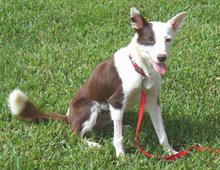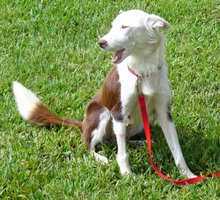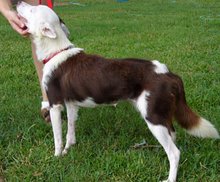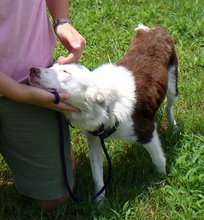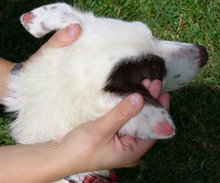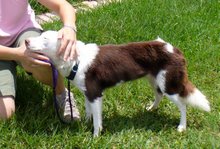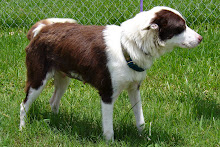Ruby has continued to improve in small steps, day by day, and remains always cheerful. Her energy level continues to improve. She can walk out to her potty area and have enough steam left to fidget a bit in her exercise pen and tear the stuffing out of two beds! She still has a long way to go, though, and is tired easily. Her coat still feels like straw and continues to fall out in clumps. I’ve also had to increase her food to two heaping cups a day in an effort to get some weight on her. Lastly, she’s still “crinkly” so I’m careful about petting her anywhere but on her face, chin and chest and a small spot on her belly, of course. But Ruby doesn’t care, she’s thrilled for any attention she gets!
She’s adjusted quickly to life in a real house. It took a good five minutes for her to screw up the courage to walk through the garage and into the house the first time. She spent a good 30 minutes just cautiously wandering the house sniffing and retreating from things like tile, trashcans, potted plants and even the resident squeaky toys. You should have seen her reaction to the beaver squeaky toy on the floor—she must have jumped fifty feet! I’m pleased to see she’s cautious and careful about new places, but not terrified. She has bounce-back; it doesn’t take her long to find the courage to give scary things another inspection, all on her own without any help from me. That’s an impressive trait considering she’s likely been chained in the yard her whole life.
She’s still in such a fragile state that she’s being tucked safely away from my other dogs in the house. She can watch the activities of the household and sit with me while I work on the computer, but she’ll stay separated for another few weeks, or at least until there are no more air pockets under her skin and she’s gained weight and strength. Since she still has air pockets, we can’t be sure the trachea has healed completely, so there’s no guaratee she will not collapse a lung if excited by the other dogs.
Death from Distemper or heartworms is not quick, the suffering is immense. There is no cure for Distemper, and any treatment available is only meant to ease suffering or help the dog stay strong enough to attempt to fight the virus on it’s own. Distemper slowly destroys, the lymphoid organs, respiratory organs, gastrointestinal organs, and urogenital organs, one-by-one. Most dogs that die from distemper, die from neurological complications, many of which are horrific to witness: swelling of the brain, seizures, deterioration of mental and muscle function, paralysis, disabling muscle spasms, depression and an increased sensitivity to stimuli like pain or touch. Heartworms is as equally devastating. Read Livy’s story to understand why waiting to see if a dog gets heartworms to take action is not only expensive but very, very dangerous for the dog.
Ruby was very, very lucky to have survived and found a wonderful home to live out a healthy and happy life. Her illnesses were easily avoidable with simple and relatively inexpensive preventive measures. Sadly, heartworm prevention costs only about $7-$10 a month, and the DHLP-P vaccination, which protects against more than just Distemper, costs only about $8-$12 a year. The cost in your time to carry out this prevention is even less. We hope that Ruby’s story (below) and the suffering she had to endure will educate so that other dogs don't have to suffer or die from these preventable diseases.
Ruby was very, very lucky to have survived and found a wonderful home to live out a healthy and happy life. Her illnesses were easily avoidable with simple and relatively inexpensive preventive measures. Sadly, heartworm prevention costs only about $7-$10 a month, and the DHLP-P vaccination, which protects against more than just Distemper, costs only about $8-$12 a year. The cost in your time to carry out this prevention is even less. We hope that Ruby’s story (below) and the suffering she had to endure will educate so that other dogs don't have to suffer or die from these preventable diseases.

May 25: My German Shepherd

May 17: Olivia, Henrietta, Sunshine and Ruby

April 10: First Trip to the Beach












